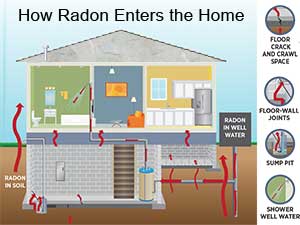Radon is a serious health concern  for homeowners across the globe. As the second leading cause of lung cancer after smoking, radon can poses significant risks to occupants of homes where it accumulates. Therefore, you should test for radon in your home to assess your exposure levels and take appropriate measures to mitigate any risks to yourself or your family. In this article we’ll look at the importance of radon testing to safeguard your health and create a safer living environment.
for homeowners across the globe. As the second leading cause of lung cancer after smoking, radon can poses significant risks to occupants of homes where it accumulates. Therefore, you should test for radon in your home to assess your exposure levels and take appropriate measures to mitigate any risks to yourself or your family. In this article we’ll look at the importance of radon testing to safeguard your health and create a safer living environment.
What is Radon?
Radon is a naturally occurring radioactive gas that originates from the decay of uranium in soil, rock and water. It is colorless, odorless, and tasteless, making it undetectable without specialized equipment.
The U.S. Environmental Protection Agency (EPA) has designated certain areas of the country as “Zone 1” regions, meaning they have the highest potential for elevated radon levels. They include parts of the Virginia, Maryland, and D.C. regions of the U.S. (See the EPA Zone Map.) The extent to which radon affects a home depends on the concentration of radon in the soil, the permeability of the soil and foundation, and the ventilation and airflow within the building. Homes with basements or crawl spaces are often at higher risk due to the direct underground contact between the soil and the living space above.
Who is Susceptible?
All homeowners, regardless of their location or housing type, are susceptible. Radon can seep into buildings through cracks in the foundation, gaps in the walls, or openings around pipes and utility lines.
Once inside, the primary concern with radon in homes is its radioactive decay products which can attach to dust particles in the air and be inhaled into the lungs. This exposes lung tissue to radiation, increasing the risk of lung cancer, particularly over prolonged periods. It can also suggest links between other respiratory issues such as chronic obstructive pulmonary disease (COPD). Radon is classified as a Group 1 carcinogen by the International Agency for Research on Cancer (IARC).
Testing for Radon in your Home
Detecting radon in the home can be challenging as it does not produce any immediate symptoms such as headaches or nausea. The only reliable method for identifying it is through testing. Homeowners can conduct their own tests through short-term radon testing kits that last between two to seven days. Long-term tests are conducted over a minimum of three months to provide a more comprehensive assessment of radon exposure.
While it is possible to conduct a test on your own, hiring a professional radon testing service is recommended. Professionals use specialized equipment and follow standardized protocols to ensure accurate and reliable results. Both short-term and long-term testing options are available based on your needs. Short-term tests may be appropriate for a quick snapshot for an initial assessment or real estate transaction, while long-term tests offer a more comprehensive evaluation.
Your professional knows the proper placement of radon testing devices to ensure representative measurements and can offer recommendations for follow-up actions based on test results. Additionally, hiring a professional can streamline the testing process, helping those with limited time or technical expertise.
How Often Should a Homeowner Test for Radon?
Given the potential health risks associated with radon exposure, it is advisable for homeowners to test their homes ideally every two to five years.
Local Recommendations for Testing
Northern Virginia: The Virginia Department of Health (VDH) provides information on testing and mitigation through its Radon Program. Some jurisdictions may also have specific requirements or recommendations regarding testing and mitigation, and disclosure requirements when purchasing or selling a home.
Maryland: Regulations are guided by the Maryland Radon Awareness Act requiring sellers of residential property to disclose to buyers whether the property has been radon tested, and if so, to provide a copy of the test results. Sellers must provide buyers with a radon disclosure form that includes information about radon, its health risks, and the importance of testing. Testing is recommended every two years by the Maryland Department of the Environment (MDE) which oversees radon-related activities in the state.
Washington, DC: Radon or radon testing regulations are primarily guided by the Radon Awareness Act of 2013 that requires residential property sellers to disclose to buyers whether the property has been tested for radon, and to provide a copy of the test results. Sellers must provide buyers with a radon disclosure form. The District of Columbia Department of Energy and Environment (DOEE) recommends homeowners test their homes for radon every two years, particularly if there are changes to the home’s foundation or ventilation systems.
Local Testing through Först Consulting Services
In the Washington DC metropolitan area, trust Först Consulting Services with your radon testing. We are knowledgeable about testing procedures and install the correct equipment to detect and report on radon levels in your home. You will receive a comprehensive radon report along with methods to mitigate radon levels and maintain and healthy environment should higher-than-recommended levels be indicated.
For radon testing, or other forensic testing including thermal imaging and noise testing, contact Först Consulting Group.




